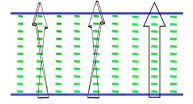(Press-News.org) WASHINGTON, Oct. 22, 2014—At first glance, the static, greyscale display created by a group of researchers from the Hong Kong University of Science and Technology, China might not catch the eye of a thoughtful consumer in a market saturated with flashy, colorful electronics. But a closer look at the specs could change that: the ultra-thin LCD screen described today in a paper in The Optical Society's (OSA) journal Optics Letters is capable of holding three-dimensional images without a power source, making it a compact, energy-efficient way to display visual information.
Liquid crystal displays (LCDs) are used in numerous technological applications, from television screens to digital clock faces. In a traditional LCD, liquid crystal molecules are sandwiched between polarized glass plates. Electrodes pass current through the apparatus, influencing the orientation of the liquid crystals inside and manipulating the way they interact with the polarized light. The light and dark sections of the readout display are controlled by the amount of current flowing into them.
The new displays ditch the electrodes, simultaneously making the screen thinner and decreasing its energy requirements. Once an image is uploaded to the screen via a flash of light, no power is required to keep it there. Because these so-called bi-stable displays draw power only when the image is changed, they are particularly advantageous in applications where a screen displays a static image for most of the time, such as e-book readers or battery status monitors for electronic devices.
"Because the proposed LCD does not have any driving electronics, the fabrication is extremely simple. The bi-stable feature provides a low power consumption display that can store an image for several years," said researcher Abhishek Srivastava, one of the authors of the paper.
The researchers went further than creating a simple LCD display, however —they engineered their screen to display images in 3D. Real-world objects appear three-dimensional because the separation between your left eye and your right creates perspective. 3D movies replicate this phenomenon on a flat screen by merging two films shot from slightly different angles, and the glasses that you wear during the film selectively filter the light, allowing one view to reach your left eye and another to fall on your right to create a three-dimensional image.
However, instead of displaying multiple images on separate panels and carefully aligning them—a tedious and time-consuming process—the researchers create the illusion of depth from a single image by altering the polarization of the light passing through the display. They divide the image into three zones: one in which the light is twisted 45 degrees to the left, another in which it is twisted 45 degrees to the right, and a third in which it is unmodified. When passed through a special filter, the light from the three zones is polarized in different directions. Glasses worn by the viewer then make the image appear three-dimensional by providing a different view to each eye.
This technology isn't ready to hit the television market just yet: it only displays images in greyscale and can't refresh them fast enough to show a film. However, Srivastava and his colleagues are in the process of optimizing their device for consumer use by adding color capabilities and improving the refresh rate. The thin profile and minimal energy requirements of devices could also make it useful in flexible displays or as a security measure on credit cards.
INFORMATION:
"Optically Rewritable 3D Liquid Crystal Displays," J. Sun et al., Optics Letters, Vol. 39, Issue 21, pp. 6209-6212 (2014).
About Optics Letters
Published by The Optical Society (OSA), Optics Letters offers rapid dissemination of new results in all areas of optics with short, original, peer-reviewed communications. Optics Letters covers the latest research in optical science, including optical measurements, optical components and devices, atmospheric optics, biomedical optics, Fourier optics, integrated optics, optical processing, optoelectronics, lasers, nonlinear optics, optical storage and holography, optical coherence, polarization, quantum electronics, ultrafast optical phenomena, photonic crystals, and fiber optics. This journal, edited by Xi-Cheng Zhang of the University of Rochester and published twice each month, is where readers look for the latest discoveries in optics. Visit http://www.OpticsInfoBase.org/OL.
About OSA
Founded in 1916, The Optical Society (OSA) is the leading professional organization for scientists, engineers, students and entrepreneurs who fuel discoveries, shape real-life applications and accelerate achievements in the science of light. Through world-renowned publications, meetings and membership initiatives, OSA provides quality research, inspired interactions and dedicated resources for its extensive global network of optics and photonics experts. OSA is a founding partner of the National Photonics Initiative and the 2015 International Year of Light. For more information, visit http://www.osa.org.
Tropical Depression Nine formed over the western Bay of Campeche, Gulf of Mexico and is forecast to make a quick landfall on Mexico's Yucatan Peninsula. NOAA's GOES-East Satellite captured the birth of the depression.
NOAA's GOES-East Satellite captured an image of the birth of Tropical Depression 9 on Oct. 22 at 1600 UTC (12 p.m. EDT) in the western Bay of Campeche. The clouds associated with the depression stretched over the Yucatan Peninsula and into the western Caribbean Sea.
On Oct. 22, a Tropical Storm Warning was in effect from Celestun to Frontera, Mexico. The ...
Beta Pictoris is a young star located about 63 light-years from the Sun. It is only about 20 million years old and is surrounded by a huge disc of material — a very active young planetary system where gas and dust are produced by the evaporation of comets and the collisions of asteroids.
Flavien Kiefer (IAP/CNRS/UPMC), lead author of the new study sets the scene: "Beta Pictoris is a very exciting target! The detailed observations of its exocomets give us clues to help understand what processes occur in this kind of young planetary system."
For almost 30 years ...
Tiny soil microbes are among the world's biggest potential amplifiers of human-caused climate change, but whether microbial communities are mere slaves to their environment or influential actors in their own right is an open question. Now, research by an international team of scientists from the U.S., Sweden and Australia, led by University of Arizona scientists, shows that a single species of microbe, discovered only very recently, is an unexpected key player in climate change.
The findings, published in the journal Nature, should help scientists improve their simulations ...
CANCER RESEARCH UK and UCL scientists have discovered that the same specialised immune cells that patrol the body and spot infections also trigger the expansion of immune organs called lymph nodes, according to a study* published in Nature today (Wednesday).
The immune system defends the body from infections and can also spot and destroy cancer cells. Lymph nodes are at the heart of this response, but until now it has never been explained how they expand during disease.
The researchers – at Cancer Research UK's London Research Institute – found that when ...
Sequencing the genomes of tumor cells has revealed thousands of genetic mutations linked with cancer. However, sifting through this deluge of information to figure out which of these mutations actually drive cancer growth has proven to be a tedious, time-consuming process.
MIT researchers have now developed a new way to model the effects of these genetic mutations in mice. Their approach, based on the genome-editing technique known as CRISPR, is much faster than existing strategies, which require genetically engineering mice that carry the cancerous mutations.
"It's ...
Thermal paper, sometimes used in cash register receipts, may be a potential source of exposure to the hormone disruptor bisphenol-A (BPA), according to a study published October 22, 2014 in the open-access journal PLOS ONE by Annette Hormann from University of Missouri and colleagues.
Results showed that when men and women handled a thermal receipt after using a hand sanitizer, there was a very large amount of BPA transferred from the receipt to the hand, resulting in a rapid increase in blood levels of BPA.
Bisphenol A (BPA) is used in a wide variety of products, and ...
COLUMBIA, Mo. – Bisphenol A (BPA) is a chemical that is used in a variety of consumer products, such as water bottles, dental composites and resins used to line metal food and beverage containers, and also is used in thermal paper cash register receipts. Now, research conducted at the University of Missouri is providing the first data that BPA from thermal paper used in cash register receipts accounts for high levels of BPA in humans. Subjects studied showed a rapid increase of BPA in their blood after using a skin care product and then touching a store receipt with ...
A report by Chinese researchers in the journal Nature a few months ago was a small sensation: they appeared to have found the cause for why organisms age. An international team of scientists, headed by the University of Bonn, has now refuted a basic assumption of the Nature article. The reasons for aging thus remain elusive.
The Chinese article caused a stir amongst experts worldwide. Using a simple measurement in young nematode worms, the researchers reported they had been able to predict how long they would live .
The researchers had introduced a fluorescent probe ...
Unmanned aerial vehicles, or drones, can collect detailed information in real time at relatively low cost for ecological research. In a new Opinion piece published in the Cell Press journal Trends in Parasitology, experts demonstrate that drones can be used to understand how environmental factors influence the spread of infectious diseases.
"Drones can provide highly accurate information on changes to land, such as deforestation or changing types of agriculture. This helps to understand the impact on the movement and distribution of people, animals, and insects that carry ...
Complex biochemical signals that coordinate fast and slow changes in neuronal networks keep the brain in balance during learning, according to an international team of scientists from the RIKEN Brain Science Institute in Japan, UC San Francisco (UCSF), and Columbia University in New York.
The work, reported on October 22 in the journal Neuron, culminates a six-year quest by a collaborative team from the three institutions to solve a decades-old question and opens the door to a more general understanding of how the brain learns and consolidates new experiences on dramatically ...






